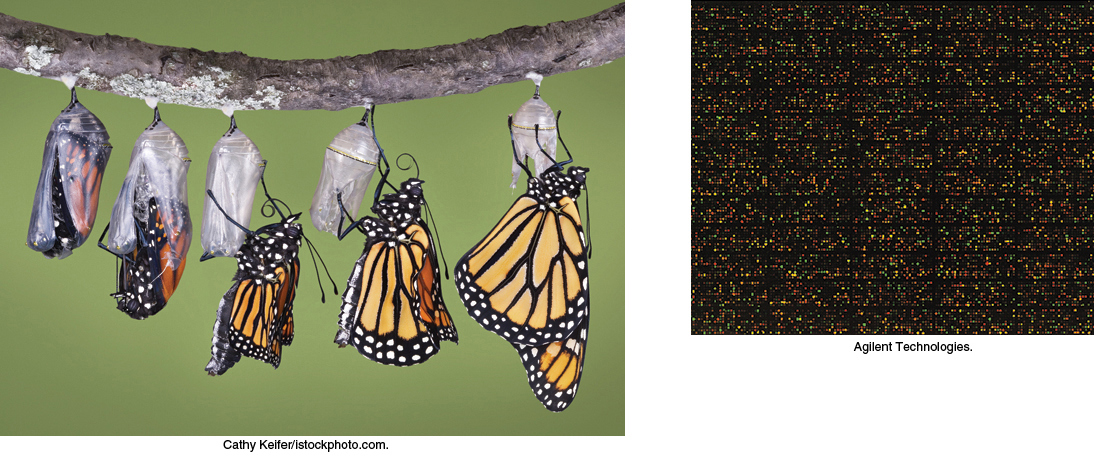Exploring Genes and Genomes

Processes such as the development from a caterpillar into a butterfly entail dramatic changes in patterns of gene expression. The expression levels of thousands of genes can be monitored through the use of DNA arrays. At the right, a DNA microarray reveals the expression levels of more than 12,000 human genes; the brightness and color of each spot indicates a change in the expression level of the corresponding gene.
[(Left) Cathy Keifer/istockphoto.com. (Right) Agilent Technologies.]
Since its emergence in the 1970s, recombinant DNA technology has revolutionized biochemistry. The genetic endowment of organisms can now be precisely changed in designed ways. Recombinant DNA technology is the fruit of several decades of basic research on DNA, RNA, and viruses. It depends, first, on having enzymes that can cut, join, and replicate DNA and those that can reverse transcribe RNA. Restriction enzymes cut very long DNA molecules into specific fragments that can be manipulated; DNA ligases join the fragments together. Many kinds of restriction enzymes are available. By applying this assortment cleverly, researchers can treat DNA sequences as modules that can be moved at will from one DNA molecule to another. Thus, recombinant DNA technology is based on the use of enzymes that act on nucleic acids as substrates.
A second foundation is the base-pairing language that allows complementary sequences to recognize and bind to each other. Hybridization with complementary DNA (cDNA) or RNA probes is a sensitive means of detecting specific nucleotide sequences. In recombinant DNA technology, base-pairing is used to construct new combinations of DNA as well as to detect and amplify particular sequences.
Third, powerful methods have been developed for determining the sequence of nucleotides in DNA. These methods have been harnessed to sequence complete genomes: first, small genomes from viruses; then, larger genomes from bacteria; and, finally, eukaryotic genomes, including the 3-billion-base-pair human genome. Scientists are just beginning to exploit the enormous information content of these genome sequences.
Finally, recombinant DNA technology critically depends on our ability to deliver foreign DNA into host organisms. For example, DNA fragments can be inserted into plasmids, where they can be replicated within a short period of time in their bacterial hosts. In addition, viruses efficiently deliver their own DNA (or RNA) into hosts, subverting them either to replicate the viral genome and produce viral proteins or to incorporate viral DNA into the host genome.
These new methods have wide-ranging benefits across a broad spectrum of disciplines, including biotechnology, agriculture, and medicine. Among these benefits is the dramatic expansion of our understanding of human disease. Throughout this chapter, a specific disorder, amyotrophic lateral sclerosis (ALS), will be used to illustrate the effect that recombinant DNA technology has had on our knowledge of disease mechanisms. ALS was first described clinically in 1869 by the French neurologist Jean-Martin Charcot as a fatal neurodegenerative disease of progressive weakening and atrophy of voluntary muscles. ALS is commonly referred to as Lou Gehrig’s Disease, for the baseball legend whose career and life were prematurely cut short as a result of this devastating disease. For many years, little progress had been made in the study of the mechanisms underlying ALS. As we shall see, significant advances have been made with the use of research tools facilitated by recombinant DNA technology.
